Measuring the Regional Availability of Forest Biomass for Biofuels and the Potential of GHG Reduction
Abstract
:1. Introduction
2. Materials and Methods
2.1. Study Area
2.2. Timber Volume Assessment and Prediction
2.3. Harvest Residues Estimation
2.4. Implications of Use for Ethanol Production and GHG Savings
2.4.1. Biomass Conversion Technologies
2.4.2. Long Term Ethanol Probabilities
2.4.3. Long Term Energy Probabilities
2.4.4. GHG Savings Potential
3. Results and Discussion
3.1. Potential of Biomass
3.2. Potential of Ethanol
3.3. Potential of Energy and Emission Savings
4. Discussion
5. Conclusions
Acknowledgments
Author Contributions
Conflicts of Interest
References
- Judith, G. Oil Sands up Close, 2012. Center for Climate and Energy Solutions (C2ES). Available online: http://www.c2es.org/energy/source/oil (accessed on 12 March 2016).
- United States Environmental Protection Agency. (EPA). Sources of Greenhouse Gas Emissions. Available online: https://www3.epa.gov/climatechange/ghgemissions/sources/transportation.html (accessed on 15 March 2016).
- Kukrety, S.; Wilson, D.C.; D’Amato, A.W.; Becker, D.R. Assessing sustainable forest biomass potential and bioenergy implications for the northern Lake States region, USA. Biomass Bioenergy 2015, 81, 167–176. [Google Scholar] [CrossRef]
- Kannan, R.; Leong, K.C.; Osman, R.; Ho, H.K. Life cycle energy, emissions and cost inventory of power generation technologies in Singapore. Renew. Sustain. Energy Rev. 2007, 11, 702–715. [Google Scholar] [CrossRef]
- Hernandez, U.F.; Jaeger, D.; Samperio, J.I. Bioenergy Potential and Utilization Costs for the Supply of Forest Woody Biomass for Energetic Use at a Regional Scale in Mexico. Energies 2017, 10, 1192. [Google Scholar] [CrossRef]
- Crawford, D.F.; O’Connor, M.H.; Jovanovic, T.; Herr, A.; Raison, R.J.; O’Connell, D.A.; Baynes, T. A spatial assessment of potential biomass for bioenergy in Australia in 2010, and possible expansion by 2030 and 2050. GCB Bioenergy 2016, 8, 707–722. [Google Scholar] [CrossRef]
- Zhang, C.X.; Zhang, L.M.; Xie, G.D. Forest Biomass Energy Resources in China: Quantity and Distribution. Forests 2015, 6, 3970–3984. [Google Scholar] [CrossRef]
- Woch, F.; Hernik, J.; Wyrozumska, P.; Czesak, B. Residual Woody Waste Biomass as an Energy Source—Case Study. Pol. J. Environ. Stud. 2015, 24, 355–358. [Google Scholar] [CrossRef]
- Department of Energy. U.S. Billion-Ton Update: Biomass Supply for a Bioenergy and Bioproducts Industry; Oak Ridge National Laboratory: Oak Ridge, TN, USA, 2011.
- Van Deusen, P.C.; Roesch, F.A. Alternative definitions of growth and removals and implications for forest sustainability. Forestry 2008, 81, 176–182. [Google Scholar] [CrossRef]
- Leefers, L.A.; Vasievich, M.J. Timber Resources and Factors Affecting Timber Availability and Sustainability for Kinross, Michigan 2011. Available online: http://www.michiganforestbiofuels.org/sites/default/files/Attachment%201_Feedstock%20Inventory%20report_v3_01072011.pdf (accessed on 20 August 2017).
- Gan, J.; Smith, C.T. Availability of logging residues and potential for electricity production and carbon displacement in the USA. Biomass Bioenergy 2006, 30, 1011–1020. [Google Scholar] [CrossRef]
- Galik, C.S.; Abt, R.C.; Wu, Y. Forest biomass supply in the Southeastern United States—Implications for industrial roundwood and bioenergy production. J. For. 2009, 107, 69–77. [Google Scholar]
- Munsell, J.F.; Germain, R.H. Woody biomass energy: An opportunity for silviculture on nonindustrial private forestlands in New York. J. For. 2007, 105, 398–402. [Google Scholar]
- Aguilar, F.; Garrett, H.E. Perspectives of Woody Biomass for Energy: Survey of State Foresters, State Energy Biomass Contacts, and National Council of Forestry Association Executives. J. For. 2009, 107, 297–306. [Google Scholar]
- Becker, D.R.; Eryilmaz, D.; Klapperich, J.J.; Kilgore, M.A. Social availability of residual woody biomass from non-industrial private woodlands in Minnesota and Wisconsin. Biomass Bioenergy 2013, 56, 82–91. [Google Scholar] [CrossRef]
- Butler, B.J.; Ma, Z.; Kittredge, D.B.; Catanzaro, P.F. Social versus biophysical availability of wood in the northern United States. North. J. Appl. For. 2010, 27, 151–159. [Google Scholar]
- Becker, D.R.; Skog, K.; Hellman, A.; Halvorsen, K.E.; Mace, T. An outlook for sustainable forest bioenergy production in the Lake States. Energy Policy 2009, 37, 5687–5693. [Google Scholar] [CrossRef]
- Jakes, P.J.; Smith, W.B. Michigan’s Predicted Timber Yields 1981–2010; U.S. Department of Agriculture, Forest Service, North Central Forest Experiment Station: St. Paul, MN, USA, 1983; p. 98. Available online: Http://www.nrs.fs.fed.us/pubs/rp/rp_nc243.pdf (accessed on 3 May 2016).
- Sherrill, S.B.; MacFarlane, D.W. Measures of Wood Resources in Lower Michigan: Wood Residues and the Saw Timber Content of Urban Forests. Available online: http://www.semircd.org/ash/research/sherrill_macfarlane_inventory_final.pdf (accessed on 3 May 2016).
- MacFarlane, D.W. Potential availability of urban wood biomass in Michigan: Implications for energy production, carbon sequestration and sustainable forest management in the, U.S.A. Biomass Bioenergy 2009, 33, 628–634. [Google Scholar] [CrossRef]
- Mueller, L.S.; Shivan, G.C.; Potter-Witter, K. Michigan Woody Biomass Supply Snapshot; Report to the Forestry Biofuels Statewide Collaboration Center; Michigan Economic Development Corporation: Lansing, MI, USA, 2010. [Google Scholar]
- Brunner, A.; Currie, W.S.; Miller, S. Cellulosic ethanol production: Landscape scale net carbon strongly affected by forest decision making. Biomass Bioenergy 2015, 83, 32–41. [Google Scholar] [CrossRef]
- Gahagan, A.; Giardina, C.P.; King, J.S.; Binkley, D.; Pregitzer, K.S.; Burton, A.J. Carbon fluxes, storage and harvest removals through 60 years of stand development in red pine plantations and mixed hardwood stands in Northern Michigan, USA. For. Ecol. Manag. 2015, 337, 88–97. [Google Scholar] [CrossRef]
- Weldemichael, Y.; Assefa, G. Assessing the energy production and GHG (greenhouse gas) emissions mitigation potential of biomass resources for Alberta. J. Clean. Prod. 2016, 112, 4257–4264. [Google Scholar] [CrossRef]
- Veronika, D.; van Dam, J.; Faaij, A. Estimating GHG emission mitigation supply curves of large-scale biomass use on a country level. Biomass Bioenergy 2007, 31, 46–65. [Google Scholar]
- Winchester, N.; Reilly, J.M. The Contribution of Biomass to Emissions Mitigation under a Global Climate Policy. 2015. Available online: https://globalchange.mit.edu/sites/default/files/MITJPSPGC_Rpt273.pdf (accessed on 14 December 2017).
- Forest Inventory and Analysis. FIA Standard Reports. 2009. Available online: http://fiatools.fs.fed.us/fido/standardrpt.html (accessed on 22 March 2016).
- Mueller, L.S.; Potter-Witter, K. Regional variation of non-Industrial private forest owners in Michigan. In Poster Abstract, Proceedings of the Society of American Foresters National Convention, Albuquerque, NM, USA, 27–30 October 2010; Society of American Foresters: Bethesda, MD, USA, 2010; CD-ROM. [Google Scholar]
- Michigan Forest Descriptors. Available online: http://mff.dsisd.net/TreeBasics/Descriptors.htm (accessed on 13 May 2016).
- Darius, A.M.; Haynes, R.W.; Daigneault, A.J. Estimated Timber Harvest by U.S. Region and Ownership, 1950–2002. 2006. Available online: https://www.fs.usda.gov/treesearch/pubs/21682 (accessed on 9 January 2018).
- Pedersen, L. Michigan State Forest Timber Harvest Trends. A Review of Recent Harvest Levels and Factors Influencing Future Levels. 2005. Available online: http://www.michigan.gov/documents/dnr/TimberHarvestTrends_173133_7.pdf (accessed on 10 May 2016).
- D’Amato, A.W.; Bolton, N.W.; Blinn, C.R.; Ek, A.R. Current Status and Long-Term Trends of Silvicultural Practices in Minnesota: A 2008 Assessment; Staff Paper Series No. 205; Department of Forest Resources, University of Minnesota: St. Paul, MN, USA, December 2009; p. 58. Available online: http://mn.gov/frc/documents/council/UMN_silvics_Staffpaper205_2008report.pdf (accessed on 12 February 2016).
- Sundstrom, S.; Nielsen-Pincus, M.; Moseley, C.; McCaffery, S. Woody biomass use trends, barriers, and strategies: Perspectives of US Forest Service Managers. J. For. 2012, 110, 16–24. [Google Scholar] [CrossRef]
- Tessa Systems, LLC. Forest-Based Woody Biomass Assessment for Michigan’s Upper Peninsula. Final Report Prepared for the Michigan Economic Development Corporation. Available online: http://mff.dsisd.net/biomass/BiomassDocs/Tessa-UP-2010.pdf (accessed on 12 February 2016).
- Potter-Witter, K. Michigan Timber Available to Harvest. Available online: http://fbis.mtu.edu/caveats.pdf (accessed on 12 February 2016).
- Abbas, D.; Handler, R.; Lautala, P.; Hartsough, B.; Dykstra, D.; Hembroff, L. A Survey Analysis of Forest Harvesting and Transportation Operations in Michigan. Croat. J. For. Eng. 2014, 35, 179–192. [Google Scholar]
- Handler, R.M.; Shonnard, D.R.; Lautala, P.; Abbas, D.; Srivastava, A. Environmental impacts of roundwood supply chain options in Michigan: Life-cycle assessment of harvest and transport stages. J. Clean. Prod. 2014, 76, 64–73. [Google Scholar] [CrossRef]
- Thomas, A.C. Managing Logging Residue under the Timber Sale Contract; Res. Note PNW-RN-348; U.S. Department of Agriculture, Forest Service, Pacific Northwest Forest and Range Experiment Station: Portland, OR, USA, 1980.
- Srirangan, K.; Akawi, L.; Moo-Young, M.; Chou, C.P. Towards sustainable production of clean energy carriers from biomass resources. Appl. Energy 2012, 100, 172–186. [Google Scholar] [CrossRef]
- Mcgill University & IATA. The 2nd Generation Biomass Conversion Efficiency. Available online: http://www.academia.edu/3166371/2nd_Generation_Biomass_Conversion_Efficiency (accessed on 12 May 2016).
- Wilson, D.C.; Domke, G.M.; Ek, A.R. Forest Age Class Change Simulator (FACCS): A Spreadsheet-Based Model for Estimation of Forest Change and Biomass Availability. 2014. Available online: http://conservancy.umn.edu/bitstream/handle/11299/170674/Staffpaper228.pdf?sequence=3&isAllowed=y (accessed on 24 February 2016).
- Murphy, J.D.; Mccarthy, K. Ethanol production from energy crops and wastes for use as a transport fuel in Ireland. Appl. Energy 2005, 82, 148–166. [Google Scholar] [CrossRef]
- Cambero, C.; Sowlatia, T.; Pavel, M. Economic and life cycle environmental optimization of forest-based biorefinery supply chains for bioenergy and biofuel production. Chem. Eng. Res. Des. 2016, 107, 218–235. [Google Scholar] [CrossRef]
- DEFRA: 2008 Guidelines to Defra’s GHG Conversion Factors Annex 1; HMSO (Department for Environment Food and Rural Affairs): London, UK, 2007; Available online: http://www.aef.org.uk/downloads/ghg-cf-guidelines-annexes2008.pdf (accessed on 25 August 2017).
- Penn State’s Renewable and Alternative Energy Program. Renewable and Alternative Energy Fact Sheet: Characteristics of Biomass as a Heating Fuel. Available online: http://www.biomassinnovation.ca/pdf/factsheet_PennState_BiomassProperties.pdf (accessed on 18 December 2017).
- Mead, D.J. Forest for energy and the role of planted trees. Crit. Rev. Plant Sci. 2005, 24, 407–421. [Google Scholar] [CrossRef]
- Adams, P.W. Estimating biomass in northern lower Michigan forest stands. For. Ecol. Manag. 1982, 4, 275–286. [Google Scholar] [CrossRef]
- Hossen, M.M.; Rahman, A.H.; Kabir, A.S.; Hasan, M.M.; Ahmed, S. Systematic assessment of the availability and utilization potential of biomass in Bangladesh. Renew. Sustain. Energy Rev. 2017, 67, 94–105. [Google Scholar] [CrossRef]
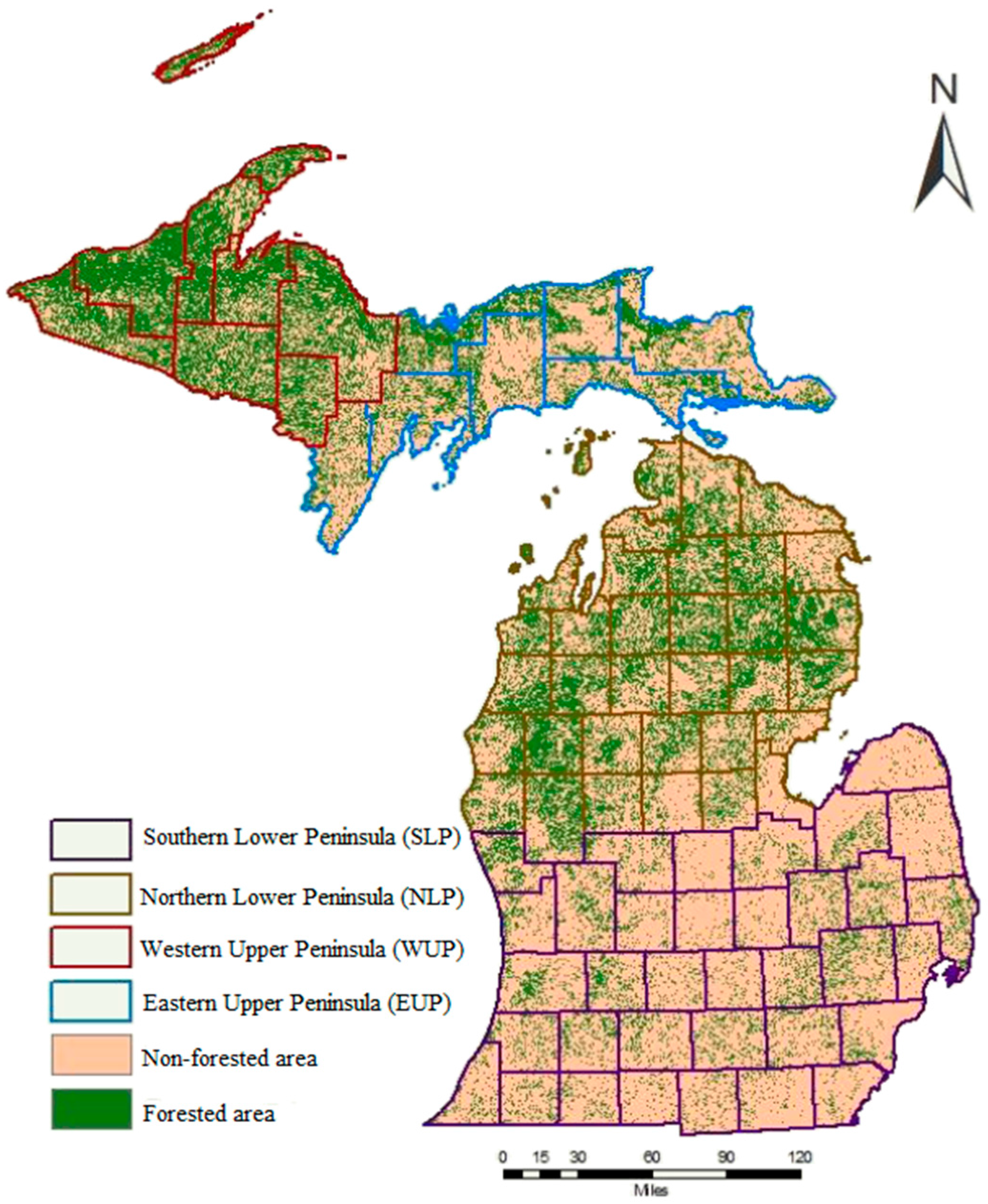

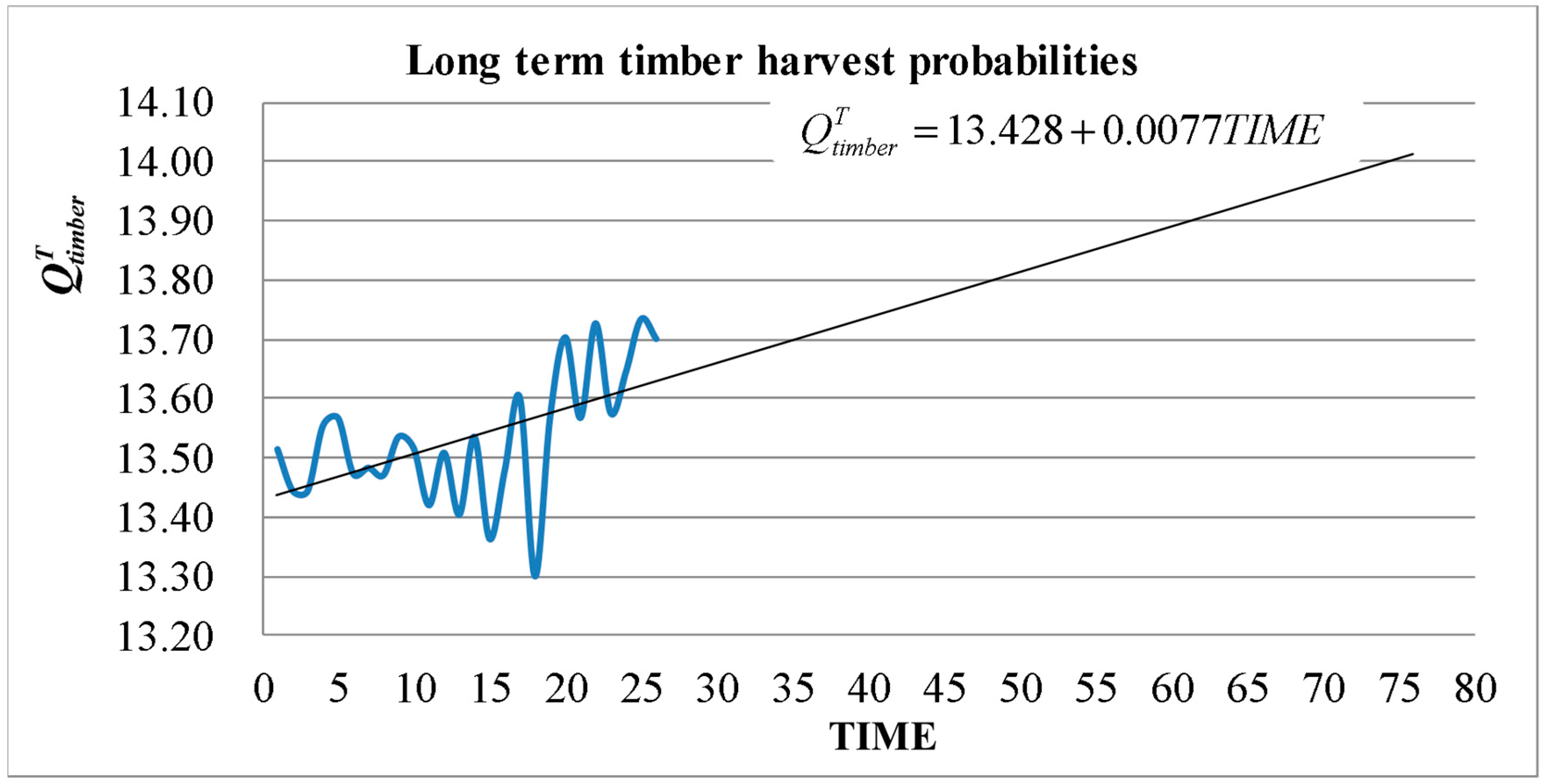
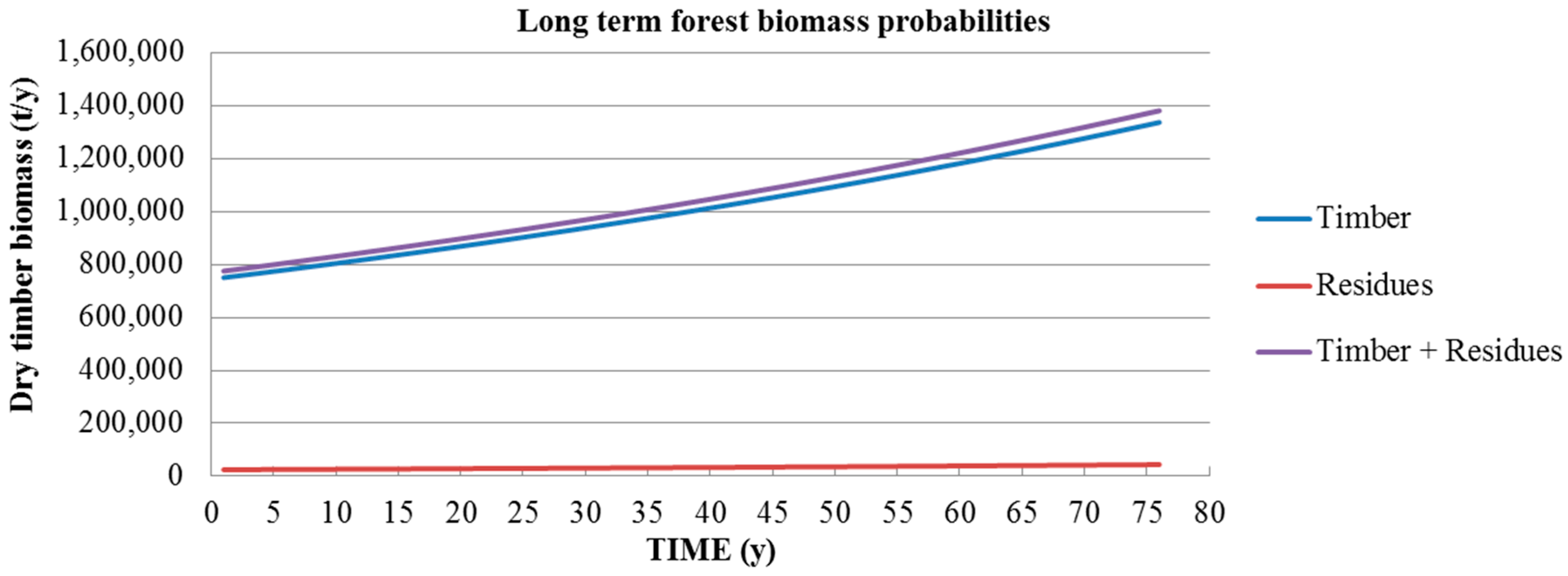
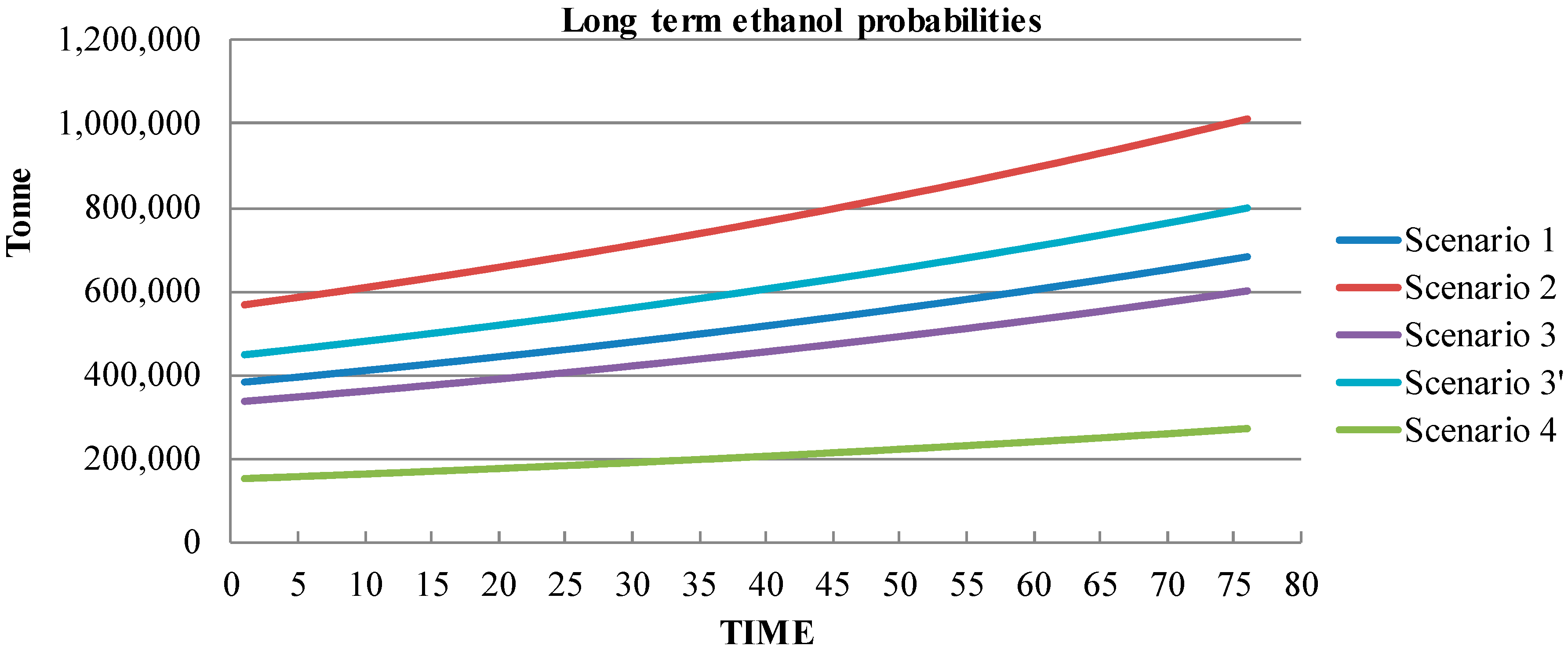
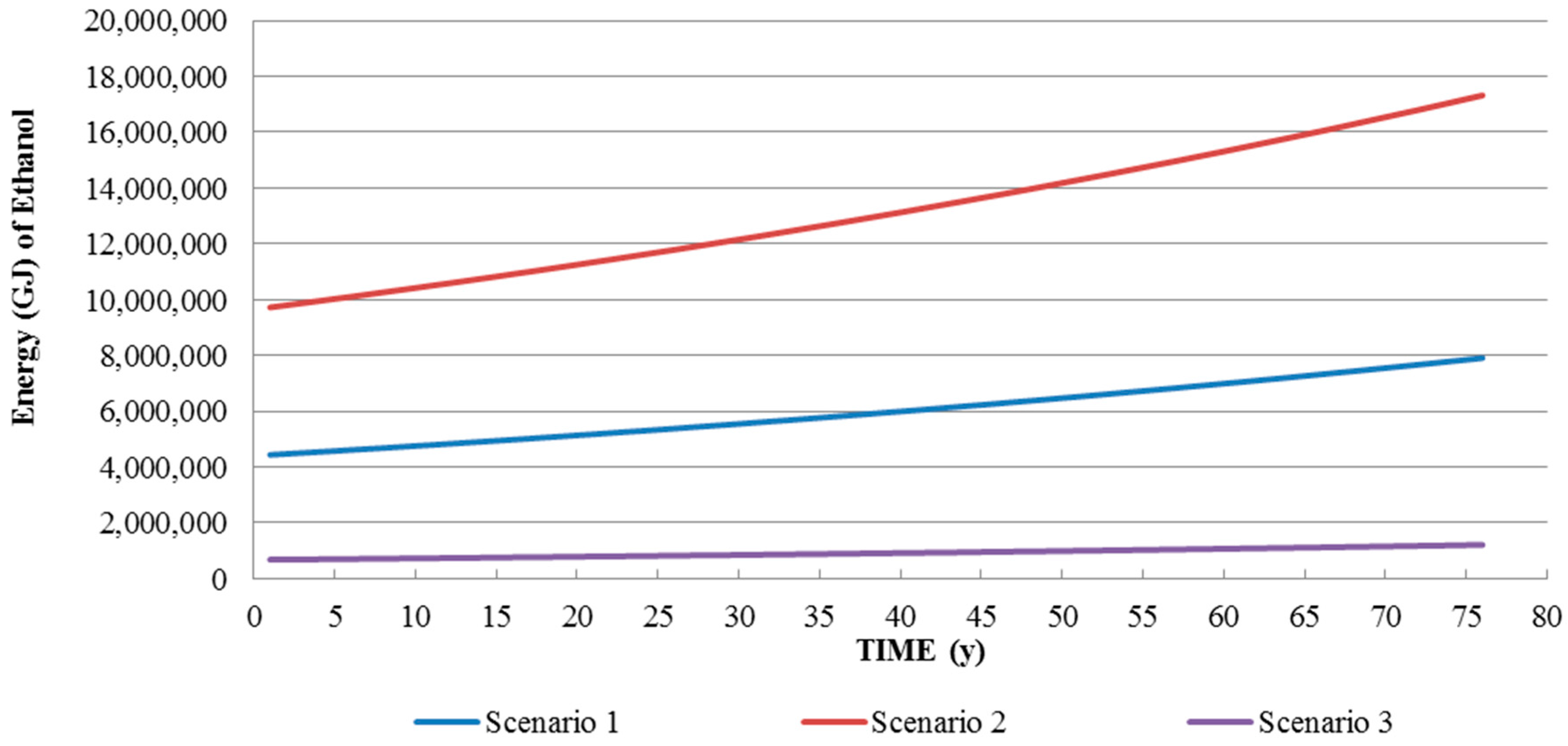

| Residue Management Options | Symbol | Percent |
|---|---|---|
| Clearcut and leave residue | Hcl | 27.8% |
| Clearcut and remove residue | Hcr | 9.9% |
| Partial removal and leave residue | Hpl | 50.9% |
| Partial removal and remove residue | Hpr | 9.7% |
| Other method | Ho | 1.7% |
| The sum | 100% | |
| Ethanol by Thermo-Chemical Process | ||
| Hardwood | Softwood | Comments |
| 0.49 | 0.52 | Without catalytic methane reformation |
| 0.73 | 0.76 | With catalytic methane reformation |
| 0.58 | - | With feedstock used for process energy |
| Ethanol by Biochemical Process | ||
| 0.195 | 0.205 | - |
| Ethanol by Thermo-Chemical Process | ||
| Hardwood | Softwood | Comments |
| 0.58 | 0.6 | Without catalytic methane reformation |
| 0.86 | 0.88 | With catalytic methane reformation |
| Ethanol by Biochemical Process | ||
| 0.23 | 0.215 | - |
© 2018 by the authors. Licensee MDPI, Basel, Switzerland. This article is an open access article distributed under the terms and conditions of the Creative Commons Attribution (CC BY) license (http://creativecommons.org/licenses/by/4.0/).
Share and Cite
Zhang, F.; Johnson, D.M.; Wang, J.; Liu, S.; Zhang, S. Measuring the Regional Availability of Forest Biomass for Biofuels and the Potential of GHG Reduction. Energies 2018, 11, 198. https://doi.org/10.3390/en11010198
Zhang F, Johnson DM, Wang J, Liu S, Zhang S. Measuring the Regional Availability of Forest Biomass for Biofuels and the Potential of GHG Reduction. Energies. 2018; 11(1):198. https://doi.org/10.3390/en11010198
Chicago/Turabian StyleZhang, Fengli, Dana M. Johnson, Jinjiang Wang, Shuhai Liu, and Shimin Zhang. 2018. "Measuring the Regional Availability of Forest Biomass for Biofuels and the Potential of GHG Reduction" Energies 11, no. 1: 198. https://doi.org/10.3390/en11010198
APA StyleZhang, F., Johnson, D. M., Wang, J., Liu, S., & Zhang, S. (2018). Measuring the Regional Availability of Forest Biomass for Biofuels and the Potential of GHG Reduction. Energies, 11(1), 198. https://doi.org/10.3390/en11010198




